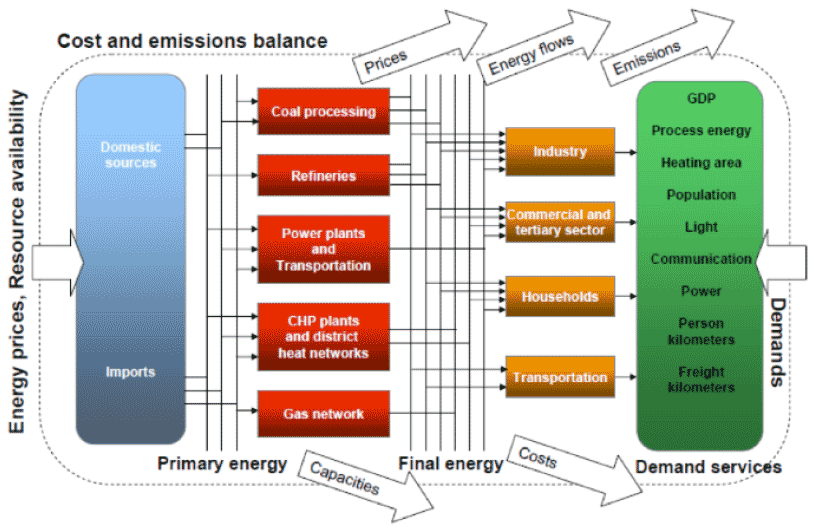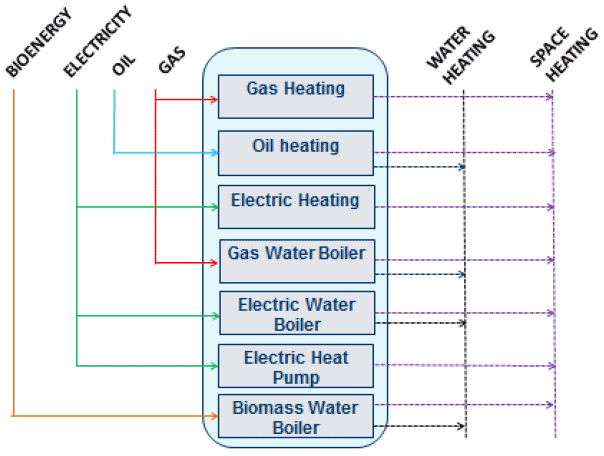Climate Change Plan: third report on proposals and policies 2018-2032 – technical annex
This annex provides an overview of the analysis underpinning the Climate Change Plan
Scottish TIMES Model
The Scottish TIMES model, at its simplest, is a diagnostic tool to help understand the key inter-relationships across the energy system. The approach relies on a specified set of data inputs being collected which capture the characteristics of the system being studied, a series of constraints being applied to reflect practical or policy constraints and a set of results being generated that are informed by those inputs and constraints.
Energy Flows
The figure below sets out a simplified overview of the TIMES model. TIMES contains a series of domestic and imported resources that the model can draw from, shown in the blue section of the figure below. The minimum or maximum amount of each resource that can be extracted or imported is set by the modeller, as well as resource prices. The modeller also inputs policy targets (such as the Scottish climate change targets), baseline energy demand for relevant sectors and drivers that influence how baseline demand will change over time. There are a range of drivers that influence demand, including number of households and service sector floor space projections, amongst others. The model is constrained to meet the defined climate change targets and energy demands over a specified time horizon.
Figure 3: TIMES Inputs and Outputs; source (Remme et al., 2001)

Primary resources can be transformed into fuels (such as hydrogen or electricity) using a range of existing and future technologies and processes (red) that are then redirected into the different sectors (orange), where they feed into a range of technologies, such as gas boilers, heat pumps, etc. that ultimately meet energy demand.
The figure below highlights a simplified version of specific supply chains within TIMES. Space and water heating in the Residential sector can be generated from gas, electricity or other sources. Electricity, in turn, can be generated using a variety of inputs, including gas.
Figure 4: Based on "Using the TIMES model in developing energy policy, 2017" [2]

However, this example highlights only one form of energy demand being considered by the TIMES approach. In addition to considering the most appropriate method of delivering heat demand, TIMES is also simultaneously considering that approach in the context of delivering all other energy demands (hot water, transport, appliances) and the impacts those demands have on competing and complimentary parts of the supply chain.
There are, in fact, over two thousand technologies and other carbon abatement measures in the Scottish TIMES model, both existing and future. There are a series of variables associated with each, such as fixed and variable operating costs, investment costs and technical potential, amongst others.
TIMES models use linear programming ( LP) to identify the least-cost pathway for meeting our climate change targets and energy demands over a specified time horizon. LP is a mathematical technique by which we obtain an optimal result by minimising or maximising a function (finding its maximum or lowest point), given a set of constraints. In the context of TIMES, we minimise the total cost of meeting a series of final demands, given a set of constraints.
The resulting pathway will include a specific mix of primary energy supply that can optimally meet Scottish energy demands. The least-cost pathway also contains a suggested mix of technologies, fuels and other carbon abatement measures for achieving our targets, as well as a set of carbon envelopes that indicate the potential future pathway for emissions within sectors.
In addition to the whole system TIMES model, we utilise a number of more detailed sector models. These have been used to compliment the TIMES whole system approach. Sector models can provide more detail on the individual sectors than is possible within the TIMES framework. We have made adjustments to the TIMES model to take into account these sector-specific analyses.
The pace at which the energy system changes (and has changed over the past decade and a half) as a result of changing market, policy, technological and regulatory drivers means forecasting the precise breakdown of the 2032 energy system is not feasible and the actual distribution of technologies and processes within and between sectors could be different over the period. For example, bioenergy is identified as being a potential input to the industrial sector, but the form this could take may differ depending on how different technologies and processes develop.
The current work underway to upgrade the mains gas system could facilitate a greater share of biogases in the gas network, which could provide a low-disruption means by which to decarbonise the non-domestic sector. This issue of how to model uncertainty was a consistent theme in our discussions with the academic modelling community, and an area that we will look to develop further as we continue to develop our modelling expertise.
Contact
There is a problem
Thanks for your feedback